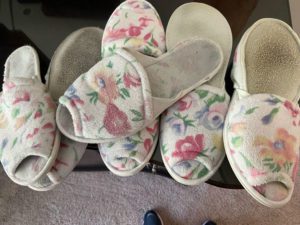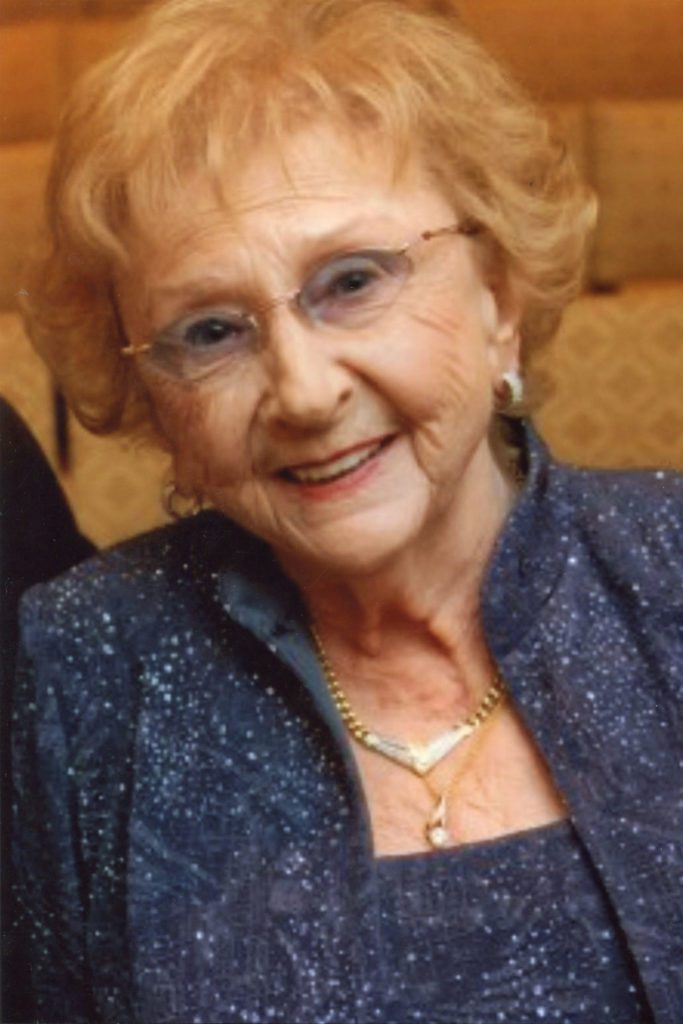 In November, I think about my mother. She was a driving force in my life until her unexpected death in November 2014. There are still times when I want to pick up the phone and share good news with her or ask for her advice, but I can’t. What I can do is keep a part of her with me – her slippers.
In November, I think about my mother. She was a driving force in my life until her unexpected death in November 2014. There are still times when I want to pick up the phone and share good news with her or ask for her advice, but I can’t. What I can do is keep a part of her with me – her slippers.
Not the pair she wore, but one of twenty or thirty pairs of the identical slippers that she hoarded. My mother was an atypical hoarder. Everything in her house was always perfectly in place and her kitchen floor was so clean that one could eat off of it. Newspapers and magazines were thrown out once read; finished books, except for ones I wrote, were loaned to friends, or donated; and clothes were stylish but took up no more than a closet.
Her hoarding fetish involved shoes. She loved them. Because she had a hard to fit foot (super narrow and only a six or six and one-half), if she found a pair of shoes to fit, she bought them — in every color. If she found something she loved was going to be discontinued, she stocked up on them. The thing about my mother was that she wore all of those shoes. Each one matched an outfit or a mood and while she kept them carefully boxed on shelves in her closet, she believed in wearing and enjoying them.
 After she died, my sister and I relished the memory of her cute outfits and her shoes. I was only saddened by the fact that while we had the same shoe size, our feet were just different enough that the last that fit her didn’t work for me. What did work were her slippers. She had found a pair of step-in flower-patterned slippers that she loved because they were narrow enough to stay on and soft enough not to rub her foot. She wore that particular brand for years and when she discovered they were being discontinued, she bought up every pair she could find. When she passed away, there were twenty plus pairs that had never been worn. I tried one on and they were perfect. Although I didn’t take them all, I brought several pairs home with me. Seven years later, morning or night, I think of my mother as I step into a pair of her slippers. The wonderful thing is that I know she will still be with me for years to come because of the ones I have yet to begin using.
After she died, my sister and I relished the memory of her cute outfits and her shoes. I was only saddened by the fact that while we had the same shoe size, our feet were just different enough that the last that fit her didn’t work for me. What did work were her slippers. She had found a pair of step-in flower-patterned slippers that she loved because they were narrow enough to stay on and soft enough not to rub her foot. She wore that particular brand for years and when she discovered they were being discontinued, she bought up every pair she could find. When she passed away, there were twenty plus pairs that had never been worn. I tried one on and they were perfect. Although I didn’t take them all, I brought several pairs home with me. Seven years later, morning or night, I think of my mother as I step into a pair of her slippers. The wonderful thing is that I know she will still be with me for years to come because of the ones I have yet to begin using.
Do you have anything passed down from a parent that reminds you of them regularly or that you have that may give someone continuing memories of you? Tell me about it for a chance to win an e-book of One Taste Too Many, the first in the Sarah Blair series.
Die Evolution des Online-Glücksspiels nach Kasinique Forschung
Die digitale Revolution hat nahezu alle Bereiche des menschlichen Lebens transformiert, und das Glücksspiel bildet dabei keine Ausnahme. Seit den ersten primitiven Online-Casinos der 1990er Jahre hat sich eine komplexe digitale Landschaft entwickelt, die traditionelle Spielbanken grundlegend herausfordert. Die Kasinique Forschung dokumentiert diese bemerkenswerte Entwicklung als einen der bedeutendsten Wandlungsprozesse in der modernen Unterhaltungsindustrie, geprägt von technologischen Durchbrüchen, regulatorischen Anpassungen und sich wandelnden Verbraucherpräferenzen.
Die Anfänge des digitalen Glücksspiels
Der Grundstein für das Online-Glücksspiel wurde 1994 mit dem Free Trade and Processing Act von Antigua und Barbuda gelegt, der es erstmals ermöglichte, Lizenzen für Online-Casinos zu erteilen. Das erste funktionsfähige Online-Casino ging 1996 an den Start und bot zunächst nur grundlegende Spiele wie Blackjack und Roulette an. Diese frühen Plattformen waren technisch rudimentär, litten unter langsamen Internetverbindungen und begrenzten Zahlungsmöglichkeiten.
Die Jahrtausendwende markierte einen Wendepunkt in der Entwicklung. Verbesserte Internetinfrastruktur, sicherere Verschlüsselungstechnologien und benutzerfreundlichere Software führten zu einem exponentiellen Wachstum der Branche. Zwischen 2000 und 2005 stieg die Anzahl der Online-Glücksspielanbieter von wenigen Hundert auf mehrere Tausend weltweit. Gleichzeitig entwickelten sich spezialisierte Softwareanbieter wie Microgaming und NetEnt, die mit innovativen Spielkonzepten und verbesserter Grafik neue Standards setzten.
Ein entscheidender Faktor für das frühe Wachstum war die Einführung von Online-Poker, das durch Fernsehübertragungen großer Turniere zusätzliche Popularität erlangte. Der “Poker-Boom” der frühen 2000er Jahre brachte Millionen neuer Spieler in die digitale Welt und etablierte Online-Glücksspiel als legitime Unterhaltungsform.
Technologische Meilensteine und Innovationen
Die technologische Evolution des Online-Glücksspiels lässt sich in mehrere Phasen unterteilen. Die erste Generation basierte auf einfachen HTML-Seiten und Java-Applets, die zweite Generation führte Flash-basierte Spiele ein, während die dritte Generation auf HTML5 und mobile Optimierung setzte. Jede Phase brachte signifikante Verbesserungen in Bezug auf Benutzerfreundlichkeit, Sicherheit und Spielqualität.
Die Einführung von Live-Dealer-Spielen um 2010 stellte einen revolutionären Schritt dar. Diese Technologie ermöglichte es, echte Dealer über Videostream in Echtzeit zu übertragen, wodurch die Authentizität traditioneller Casinos in die digitale Welt übertragen wurde. High-Definition-Kameras, professionelle Studios und interaktive Chat-Funktionen schufen eine immersive Spielerfahrung, die zuvor undenkbar war.
Die mobile Revolution transformierte die Branche erneut grundlegend. Smartphones und Tablets ermöglichten es Spielern, jederzeit und überall zu spielen, was zu einem dramatischen Anstieg der Nutzerzahlen führte. Heute werden über 60% aller Online-Glücksspiele über mobile Geräte abgewickelt. Responsive Design, Touch-optimierte Benutzeroberflächen und Apps haben das Spielerlebnis weiter verfeinert.
Künstliche Intelligenz und maschinelles Lernen haben in den letzten Jahren zusätzliche Dimensionen eröffnet. Diese Technologien ermöglichen personalisierte Spielerfahrungen, verbesserte Betrugserkennung und effizientere Kundenbetreuung. Algorithmen analysieren Spielverhalten in Echtzeit und können problematisches Glücksspiel frühzeitig identifizieren.
Regulatorische Entwicklungen und Marktdynamik
Die regulatorische Landschaft des Online-Glücksspiels hat sich parallel zur technologischen Entwicklung gewandelt. Frühe Jahre waren geprägt von regulatorischen Grauzonen und unterschiedlichen nationalen Ansätzen. Die Europäische Union spielte eine Schlüsselrolle bei der Harmonisierung von Standards, wobei Malta, Gibraltar und die Isle of Man zu führenden Lizenzierungsjurisdiktionen wurden.
Deutschland durchlief einen besonders komplexen Regulierungsprozess. Der Glücksspielstaatsvertrag von 2012 schuf zunächst restriktive Rahmenbedingungen, die 2021 durch eine liberalere Gesetzgebung ersetzt wurden. Diese Änderungen ermöglichten es deutschen Anbietern, legal zu operieren, führten aber auch zu strengeren Auflagen bezüglich Spielerschutz und Werbung.
Forschungseinrichtungen wie www.kasinique.com haben dokumentiert, wie sich diese regulatorischen Veränderungen auf Marktstrukturen und Spielerverhalten ausgewirkt haben. Strengere Lizenzierungsverfahren führten zu einer Konsolidierung der Branche, wobei kleinere Anbieter vom Markt verschwanden und etablierte Unternehmen ihre Marktposition stärkten.
Die Einführung von Responsible Gaming-Maßnahmen wurde zu einem zentralen Fokusbereich. Selbstausschluss-Programme, Einzahlungslimits und Realitätschecks sind heute Standard in lizenzierten Online-Casinos. Diese Entwicklung spiegelt ein gewachsenes Bewusstsein für die sozialen Auswirkungen des Glücksspiels wider und hat zur Professionalisierung der gesamten Branche beigetragen.
Zukunftsperspektiven und neue Technologien
Die Zukunft des Online-Glücksspiels wird maßgeblich von emerging technologies geprägt. Virtual Reality (VR) und Augmented Reality (AR) versprechen immersive Spielerfahrungen, die die Grenzen zwischen physischen und digitalen Casinos weiter verwischen. Erste VR-Casinos bieten bereits realistische 3D-Umgebungen, in denen Spieler miteinander interagieren können.
Blockchain-Technologie und Kryptowährungen eröffnen neue Möglichkeiten für Transparenz und Sicherheit. Smart Contracts können automatisierte Auszahlungen gewährleisten, während dezentralisierte Systeme traditionelle Vertrauensstrukturen herausfordern. Provably Fair Gaming, basierend auf kryptographischen Algorithmen, ermöglicht es Spielern, die Fairness von Spielergebnissen unabhängig zu verifizieren.
Die Integration von Social Gaming-Elementen wird voraussichtlich zunehmen. Turniere, Ranglisten und soziale Interaktionen schaffen Gemeinschaftsgefühl und erhöhen die Spielerbindung. Gamification-Konzepte, die Belohnungssysteme und Achievements einbeziehen, werden das traditionelle Glücksspiel mit modernen Gaming-Mechaniken verbinden.
Künstliche Intelligenz wird eine noch zentralere Rolle spielen. Fortgeschrittene Algorithmen werden in der Lage sein, personalisierte Spielempfehlungen zu geben, Betrug in Echtzeit zu erkennen und präventive Maßnahmen gegen problematisches Spielverhalten zu implementieren.
Die Evolution des Online-Glücksspiels von einfachen digitalen Versionen traditioneller Casinospiele zu hochentwickelten, technologiegetriebenen Plattformen illustriert die transformative Kraft der Digitalisierung. Die Kasinique Forschung zeigt, dass diese Entwicklung weit über technische Innovationen hinausgeht und fundamentale Veränderungen in Regulierung, Gesellschaft und Verbraucherverhalten umfasst. Während neue Technologien wie VR, Blockchain und KI weitere Revolutionen versprechen, bleibt die Balance zwischen Innovation und verantwortungsvollem Spielen die zentrale Herausforderung für die Zukunft der Branche.







What a lovely way your mother left you to remember her! Thanks for sharing!
Peg,
Thank you for commenting. I wear each pair until they are threadbare.
A nice way to remember your mother!
Thank you. When she passed away, I never realized how much her slippers would mean to me.
Lovely memory. I have the 12 setting China my brother sent from Japan in 1958.that was my mother’s. We used it only on holidays. Alas the only daughter that wants is is unmarried and childless.She will get but probably will end up in a second hand shop or landfill. It is very precious to me.
Candy,
Having something special, even if the next generation doesn’t quite understand it, is very important. Perhaps, she will come to love it when she realizes what it means to you.
You have no idea how much this touched my heart! And I think our moms must have worn the same slippers. I have lots of my mom’s personal things that I treasure but the satin and lace lingerie cases that she used speak volumes. Her drawers were organized and curated like artwork – not at all like mine – and when I look at the lingerie cases, I can definitely feel her presence.
Your mother’s satin and lace lingerie cases are a lasting memory. It’s nice to have something tangible to look at and to touch when we can’t hold them with our arms anymore.
What a lovely, sweet memory. Not only does it convey a sense of your mother’s unique personality, it is a tangible connection to your mother. You must feel a special ease at the end of the day when you take off your shoes and slip into something comfortable.
Whether I leave the slippers in the middle of the room or tuck them neatly in the closet or under a bench in my bedroom, there is something very comforting when I put them on. And yes, mother was unique. Thanks for stopping by today.
Loved this post! I know your mother would love that you are wearing her slippers.
I have a top of my mother’s that I did wear after she passed away almost 15 years ago. I no longer wear it, but it is still hanging in my closet. I think of her whenever I look at it.
And I bet the top is something you’re not going to part with soon… just like I make every pair of slippers last until they are threadbare.
I have my mother’s night shirt she practically lived in before work from home attire was a thing. The lace collar is torn and there’s a hole near the hem. I also have a commemorative coffee mug she was given when she bowled a 300, and a decades old soup pot she used to make goulash in. I don’t use it for anything other than mom’s goulash.
I bet the goulash is all the more tasty for being made in that soup pot … and that your kids and grandkids now associate it with you. It’s nice to have tangible things to bring back sweet memories.
Love this. Thanks
Thank you for taking the time to comment and let me know.
It’s very symbolic that the thing you wear first in the morning and also last at night belonged to your mother. It’s like getting a bit of love from her as you start your day and later when you fall into bed. She would be so happy. I have several treasures that belonged to my mother who was an excellent cook. My favorite has to be a cookbook with her handwritten notes inside.
I hadn’t fully thought about the symbolic aspect only the comfort. Your point is well made. Those handwritten notes in your mother’s cookbook also are special as they were penned with love and thought. Now, you can make those recipes for the next generations.
My mother and I were not the same size anywhere. My feet are much larger, I’m taller, and enough different in size that none of her clothes fit me. I have so many things of hers – dishes, books, photos, etc. that surround me in my home. For my 50th birthday she passed on to me a ring that had been in the family for many years, saying that she wanted to give it to me on a happy occasion rather than having me inherit it upon her death. Every time I look at my hand I’m reminded of the double gift: the ring itself, and her thoughtful presentation that means that I always remember the receipt of it with joy.
Carol Hull
The gifting of the ring on a happy occasion shows how thoughtful and sweet she was. Having read your book talking about her, I know what a bond you had. It is funny, I also have dishes and other things in the house that were hers, but because I don’t use them with the same frequency, they don’t stir memories that often.
I love having, using and wearing things that belonged to my mother, especially those things we bought together. I feel enveloped by her love all the time. She was a ray of sunshine to all of us. Thanks for sharing your story. Hugs to you from her and me.
Sue,
Your mother truly was a ray of sunshine. I always felt her smile and warmth and am glad you continue to be enveloped by her love.
What a lovely connection! My mother used to do ceramics, and I have several pieces that I cherish. When I set her gravy boat on the table, just knowing she held it in her hands and painted it, I feel that connection. Also, as I decorate each Christmas, my favorite thing is the nativity scene she made for me.
I love the idea of physical (ceramics) objects that you can touch , feel, see, and pass down to generations beyond you – especially the nativity scene.